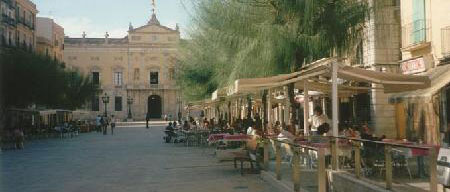Home > Study in Spain > City Guide > Tarragona
Tarragona City Guide
- Places of Interest
- Maps
- Getting to
- Getting around the city
Tarragona city is the capital of the province of the same name and is located in the south of Catalonia in the east of Spain. The city's Roman name was Tarraco and is a natural fortress as an 82m hill overlooking the sea. The people of Tarragona's native tongue is Catalan however both this and Spanish are the official languages. With a general spring climate all year round, the weather is always pleasant.
This city has officially been declared a UNESCO World Heritage Site and it is not hard to see why with the large offering of historical monuments all around the city dating as far back as the Roman times. In addition to this, Tarragona boasts a number of beautifully golden beaches with clear blue waters that make the renowned "Golden Coast" a highly popular destination. The city offers well-connected routes both around the country and internationally so it is highly accessible and at a low cost. It is also located near the holiday resort of Salou and the theme part Port Aventura, which is one of the largest in Europe. There are many festivities celebrated all through the year such as the Tarragona International Fireworks Displays Competition and the Santa Tecla Festival and it is for this immense overall cultural offering that makes this a highly popular Spanish destination for people of all ages.
Places of Interest
Casa de la Festa (House of the Festival)
This house once stored and displayed traditional items used in the Seguici Popular, a parade held in honour of the city's Santa Tecla Festival, which has been declared both an Official Spanish Tourist Attraction and a Tradition of Catalan National Interest. The "house" holds three exhibition halls which allows visitors to learn more about the celebration and in addition, a fourth hall holds audiovisual displays making it possible to recreate the excitement of the important festivities. It is important to note that on Monday everything is closed.
Les Ferreres Aqueduct/Pont del Diable Bridge
The famous Devil's Bridge was built in the city in the 1st century A. D. from large ashlars stacked without mortar to form the two tiers of arches. It was once used to supply the city's water from the Francolí River carrying more than 10 km through a network of conduits and aqueducts. Today's remaining piece is 217 metres long and almost 2 metres wide reaching an incredible height of 27 metres.
Tamarit Castle
The earliest existing records of this castle date back to the 11th century. The castle contains a number of characteristic features such as a prison, watchtowers and a Romanesque church which is one of the purest and earliest examples of Romanesque architecture within the Tarragona municipal boundaries. In the 19th century, the fishermen's village which once surrounded the castle became infested with malaria spread from the nearby villages. This site offers much historical interest and a break taking view hence a visit here should not be missed.
The Walls (Archaeological Promenade)
These 1,100m of wall are the remains of the original 3,500m built around Tarraco during 2nd century B. C. which border present-day Tarragona's Old Quarter. They are the oldest Roman construction still conserved outside Italy. Modern curtain walls were added between the 16th and 18th centuries and winding through here is the Archaeological Promenade where there is a splendour of shaded gardens, romantic poetry and historical explanations. Entry is only 3€ however remember that it is closed on Monday.
Museums
Casa Castellarnau Museum (MHT)
This museum was once home to the powerful Castellarnau family. During the Middle Ages, the city's noble families resided in Carrer Cavallers with their great homes and palaces. With a beautiful winding stairway and gothic courtyard, visitors frequently come to marvel at it along with the several rooms available to explore inside the house. All this for a mere 3€. The house is open for long hours except for on Mondays when it is closed.
Cathedral and Diocesan Museum
This is one of the city's only monuments which remains open on a Monday also. This site was once the seat of the Tarragona provincial government in the 1st century A. D. Construction of the cathedral itself began during the 12th century and it has a clear Romanesque style however with Gothic influences as building carried on through to this period. The soaring entrance and rose window of its façade are one of the city's most emblematic images. The incredible Diocesan Museum boasts a range of medieval and modern Tarragonese religious art and its diocese such as altarpieces, stone sculptures and wood carvings, gold work, textiles, coins and ceramics. Entry is free for children under 7, with a reduced price for groups, pensioners, students and those under 16.
Beaches
This is one of the city's main attractions to visitors. The city boasts 15km worth of coastline with a number of beaches. In Catalan the region's name is "Costa Daurada" or "Golden Coast" due to the well known extremely fine, golden sand. Each beach also has showers making it easy to wash off the sand. Also, with a pleasant year round climate, the beaches are popular at any time of year and have even earned Blue Flags. The Municipal Sport Council also organises numerous sport activities in the summer months.
Maps
Getting to Tarragona
By Air
Tarragona is extremely well connected to Europe and the rest of the Iberian Peninsula offering viable access through two popular airports. The first is Reus which is a mere 7km away from the city offering a number of low cost flights with Ryanair. There is a bus from the airport into Tarragona. The second is Barcelona which is 82km away with a huge number of national, international and transatlantic flights and connections daily. From here, Tarragona can be reached by train, changing at the Barcelona Sants station or by bus with the coach company ALSA.
By Train
Tarragona is on the main train line between Barcelona and Alicante. The city has two train stations with one located right in the city centre offering links to regional trains as well as national and internal long-distance trains and the second station, located just 10 minutes from the centre, is the Camp de Tarragona high speed train (AVE) station. Tarragona is approximately a 1 hour journey from Barcelona and a 2-3 hour journey from Alicante. It is also on the main line between Barcelona and Madrid which it takes 4 hours to get from. Tarragona is open to a large number of Spanish destinations by train and this means that it is easy to reach and get around if you fancy making other trips also.
By Bus
Taking the bus is a cheap and fast way of reaching your destination; Tarragona. From Barcelona airport straight into Tarragona it costs a mere 12€ one way and the bus station is very clean and well organised and located in a central location in the city so is safe at all times of the day and night if you are wishing to travel to/from there. The station offers a large host of both domestic and international routes and there are also those for most towns in the region.
By Boat
Tarragona is the city home to one of the busiest commercial ports in the Mediterranean, as well as Puerto Tarraco, a stopover for luxury cruise ships.
Getting around the city
Tarragona is comfortable city to get around in just by walking. This is also the ideal option if you are wanting to soak up the city's beauty and eye up the stunning sights during your stay. However, if you are feeling tired and are looking for a quick and easy option to travel around, the city's bus company operates 21 bus lines running throughout the city.

